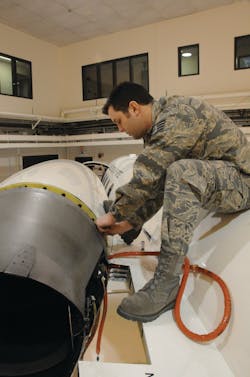The 2005 Base Realignment And Closure (BRAC) announcement to shut down flying operations at the Fargo-based North Dakota Air National Guard (NDANG) fell with a thud. With an unsurpassed safety record (more than 30 years and 145,000 flight hours in fighters without an accident) and two Hughes Trophies in the F-4 Phantom and F-16 Falcon under their belts, a melancholy mood permeated the base as the maintainers absorbed the news.
Also known as the Happy Hooligans, the 119th Wing has received major Air Force awards for maintenance, including the USAF Daedalian Maintenance Trophy. Sure, there was the C-27J Spartan on a distant horizon, but without a means of retaining personnel and their skills, a Herculean effort to rebuild maintenance skills would await them when the time came. Old talent would move to other jobs, perhaps outside their unit, and new talent would have no one to mentor them.
Bridge mission: C-21
It was a bleak picture until the announcement they’d be getting the C-21 to work during the five-or-so-year interim period — they called it a “bridge” mission. “A C-21? What is a C-21?”
They shortly learned the C-21, an off-the-shelf Learjet 35A, had always been maintained by civilian mechanics. There were no Air Force tech schools for it, no Air Force training standards for it, and tech data amounted to Learjet maintenance manuals. They felt like the Pekingese that caught the car.
The news of the airplane’s arrival surprised everyone from the Support Program Office (SPO) at Tinker AFB, OK, down to the flight line crew chiefs. The NDANG shortly learned the airplanes, victims of budget cutbacks, were being diverted from a trip to the boneyard at Davis-Monthan AFB in Tucson, AZ, for storage; the aircraft were being saved to fly another day.
Military maintenance program
At Fargo, and later at Hartford, CT, and Battle Creek, MI, training and management personnel determined how to create a military maintenance program from scratch. There were no examples to draw from; while the Air Force had moved military maintenance programs over to civilian contracting on many occasions, no one could remember such a program moving the other direction. About the only guidance was in the form of general Air Force regulations saying if it was FAA-certified, then the unit would have to maintain it to FAA standards. From this tidbit the NDANG went about the business of developing the C-21’s military maintenance program.
Essentially, program development required maintenance of the aircraft according to Federal Aviation Administration (FAA) requirements using Air Force processes. As an example, if the FAA requires a 24-month check of the aircraft pitot-static system, the job would be accomplished by Air Force technicians qualified to Air Force pitot-static system check standards. A sheet metal repair would be accomplished by a technician trained to Air Force standards, but using methods and technical data approved by the FAA. And so it went.
Learjet training
To gain an understanding of the C-21 systems, the NDANG contracted with a civilian Learjet training school to give general maintenance training to full-time technicians. A training aircraft was flown in from Wright-Patterson AFB for hands-on familiarization. From this training, technicians gained a basic understanding of the aircraft and its systems.
Avionics people learned civilian radios and equipment. Crew chiefs learned about pre-flights. Engine, hydraulic, fuel, and other specialists homed in on their specialty areas. Jobs started to become defined and organization began to take shape across the maintenance group.
As the aircraft began to show up in early 2007, the technicians observed temporary CLS personnel as they performed jobs; later CLS personnel observed as we reversed roles with them. By July 2007 Fargo was confident enough to declare a take-over of maintenance on Sept. 1, a full month before the scheduled handover date of Oct. 1.
The Air Force process
As it dug into the process, the Air Guard learned to work with FAA technical data far less detailed than Air Force Technical Orders (TOs). It learned to blend original equipment manufacturer (OEM) service bulletins and FAA Airworthiness Directives into a system of Air Force publications. It found sources for technical data not available through the SPO or OEM (like brake component manuals and emergency avionics battery data) and created methods to ensure the data was current. It gained electronic versions of tech data to accommodate Air Force electronic tech data initiatives (see sidebar). This dynamic process continues to be monitored and refined.
The Happy Hooligans created, from scratch and through conversations with engineers and Lear mechanics across the nation, the means of accomplishing Air Force-mandated processes never seen on a Learjet.
Making an aircraft "Safe for Maintenance," for instance, grew from nothing to a training class and new tech data. Phase inspections were broken down into work cards, assigning shop areas of responsibility in comprehensive, detailed steps and constructed directly from OEM maintenance manuals. Thousands of pages were written, organized, reviewed, and published to meet Air Force requirements, training goals, and to clarify processes for maintainers.
On the way, they found and corrected literally hundreds of technical data errors discovered in the FAA approved maintenance publications, reporting both to tech data monitors at the SPO and at the OEM. The technicians determined many improved methods of conducting inspections and repairs, always with an eye toward safety first and cost savings when possible. And you know what? The process works … well.
Clint Lowe holds an FAA Airframe and Powerplant certificate with Inspection Authorization and a Commercial Pilot certificate with instrument and multi engine ratings. Clint has spent most of his aviation career with the United States Air Force and Air National Guard in a variety of roles including maintenance, safety, training, oversight, and accident investigation. He has owned and maintained several aircraft and had a Part 135 air freight business for several years running bank checks. In 2007 he received the Maintenance Group Senior NCO of the Year Award. He currently is a Quality Assurance Inspector/Quality Assurance Representative with the North Dakota Air National Guard in Fargo, ND.
Closeup: Current USAF Maintenance Processes
Safety of aircraft and personnel is paramount to the USAF. To mitigate accidents, there are several major programs the Hooligans work with to prevent everything from tools being left in airplanes to people getting bad chemicals on themselves. Here are some brief highlights:
Specialists vs. A&Ps. The Air Force uses specialists trained on particular systems/processes to accomplish maintenance on the aircraft. In FAA-speak, the hydraulic specialist might best be compared to a technician holding a Repairman FAA license. Maintenance tasks are assigned according to the system (avionics, for instance) being worked on and a specialist is selected to work the issue, whether it is a phase inspection, flight line maintenance, or a tire change in the hangar. The most A & P-like is the crew chief, who is assigned to a single aircraft and assumes responsibility for its maintenance.
Consolidated Tool Kits (CTK’s). Leaving tools in airplanes is a no-no. To prevent this, the NDANG uses a combination of processes to ensure tools don’t get left behind. One portion is to “have a place for everything and everything has to be in its place,” which is done by cutting the shape of every tool in the box into a foam layer at the bottom of the drawer, which ensures the mechanic can notice a missing tool immediately during inventory. Once the inventory is complete, the technician returns the box to the tool room where another individual checks the box and then the box is scanned for turn-in and verified on TC-Max.
The tool program tracks every item in every box (each individual tool has a unique number laser-etched on it) so replacements are recorded and those tools with calibration requirements are kept on schedule. The program is also used to track location, inventories, and expiration dates of consumables like instrument grease and fuel tank sealants.
Electronic Technical Data. In the Air Force, working without current technical data right beside you is a serious offense. To ensure tech data is available for every possible task on the aircraft and save printing costs, the Air Force requires everyone to use laptops for tech data. The laptops are updated daily by ethernet connection to the main computer when stored for recharging overnight.
“Safe for Maintenance.” Prior to doing anything on an Air Force airplane, there is a requirement to make the airplane “Safe for Maintenance.” The process is intended to shut down and isolate all systems so people won’t get hurt and equipment won’t get damaged when mechanics start working on it. Radios get shut off, thrust reverser pins are double-checked, and aircraft grounding is verified. For the Learjet 35A, the "Safe for Maintenance" checklist involves roughly 50 steps, ranging from ensuring chocks by the wheels to checking the inverters are “off” prior to applying external power; throughout the document are at least as many warnings and cautions that apply to the step involved. Only after running this process can maintenance proceed on the plane.
Hazardous Materials. Everything from aircraft polish to fuel sealants are tracked on computer by location and expiration date. Industry material safety data sheets (MSDS) are maintained in the issue area to consult immediately if someone comes in contact with the material as well as to ensure proper protective gear is worn when using any item.
Phase Inspections. Manufacturers' phase inspection requirements were transferred to airline-style phase cards broken down by specialty so specialists can work all required items of a phase.
Technical Order. A Technical Order (aka Tech Order and TO) is literally a military order directing the maintainer to accomplish a task in a certain way. On military platforms, these are detailed, step-by-step instructions (remove screws, then remove panel) to perform maintenance. FAA tech data, by contrast, relies on A&P general practices and knowledge to a great extent to accomplish a job. When finishing a task on a Learjet, you often find, “Restore aircraft to normal.” In a TO, there would be a detailed process (replace panel and tighten screws to 10 inch-pounds) to accomplish this, which caused some teething pains when the C-21 first arrived.
To be sure, “Blue Suit” maintenance has been a success. Supported by a military maintenance team, the Happy Hooligans have excelled while operating in 20 countries on missions for Air Mobility Command, USCENTCOM (Middle East Operations), JOSAC (Domestic Airlift, including VIPs, humanitarian, and air ambulance) and the National Guard Bureau (NGB) in Washington, D.C. Evidence includes the 2009 JOSAC Unit of the Year Award, a record of 100 percent mission accomplishment while deployed in the Middle East, NGB Pilot Qualification Training for other C-21 units.
About the Author

Clint Lowe
Clint Lowe holds an FAA Airframe and Powerplant certificate with Inspection Authorization and a Commercial Pilot certificate with instrument and multi engine ratings. Clint has spent most of his aviation career with the United States Air Force and Air National Guard in a variety of roles including maintenance, safety, training, oversight, and accident investigation. He has owned and maintained several aircraft and had a Part 135 air freight business for several years running bank checks. In 2007 he received the Maintenance Group Senior NCO of the Year Award. He currently is a Quality Assurance Inspector/Quality Assurance Representative with the North Dakota Air National Guard in Fargo, ND.
